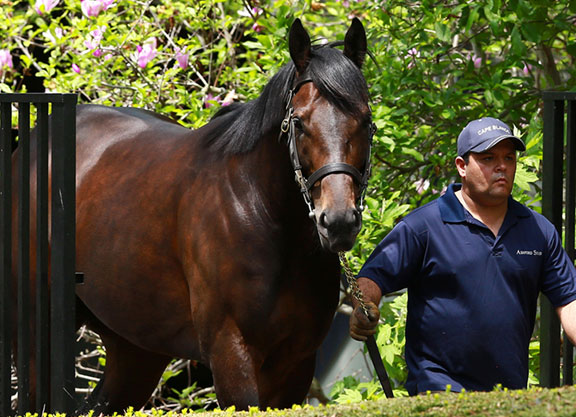By Bill Finley
For the first time since 2005, it appears that the North American foal crop did not fall in 2016 when compared to the prior year. According to the recently released Jockey Club Fact Book, an estimated 20,850 foals were born in the U.S. in 2016, the same number born in 2015.
The North American foal crop, which also includes Canada and Puerto Rico, was 22,500, also equal to 2015 figures.
The annual foal crop began to drop sharply around the time of the financial crisis in 2008 when 32,332 foals were born. But it has seen only minor declines since 2013, when the foal crop was 21,405. In 2005, the foal crop, 35,050, represented a 0.7 percent increase over numbers from the prior year.
Early indications are that the foal crop will be down in 2017. When The Jockey Club released its annual “Mares Bred” report last October it reported a 2.5 percent reduction in the number of mares bred in 2016 versus 2015. That should correlate into a 2.5 percent decline in the 2017 foal crop.
For the second straight year, Uncle Mo was bred to more mares (253) than any other stallion, a healthy increase from 2015 when he was bred to 221 mares. Into Mischief was next at 218, followed by Triple Crown winner American Pharoah (208). Having been bred to 201 mares, Kitten's Joy was fourth and the only other stallion to top the 200 mark. Goldencents, Wicked Strong and Verrazano were tied for fifth with 190 mares each.
Other nuggets from the recently released fact book:
(*) The average field size shrunk again and is now down to 7.59 horses per race. That's the lowest number since The Jockey Club first started keeping data on field size in 1950. The reduction in the number of total races run is not keeping pace with the reduction in the foal crop. Since 2006, the foal crop has declined by 41 percent, while the number of races held has declined by only 26 percent.
(*) The breeding numbers indicate that most of the reductions are coming at the expense of lesser stallions, particularly ones not in Kentucky. The average book size for a Kentucky stallion in 2016 was 76.7, while Maryland was a distant second with the number coming in at 27. Kentucky stallions accounted for 53.2 percent of all mares bred in the US in 2016. By way of comparison, in 2000 the average book size for a Kentucky stallion was 47.3 mares and Kentucky stallions accounted for only 34.6 percent of all mares bred in the U.S.
(*) Arkansas had the largest average field size of any state with 9.6 starters per race. Oaklawn is the only track in the state. Kentucky was next at 8.6.
(*) The average number of starts per horse held fairly steady in 2016 at 6.20, a slight increase from 2015 (6.18). While as recently as 1975, horses averaged 10.23 starts per year, horses are racing no less often now than they did in 2008 when the average number of starts per horse was also 6.20.
(*) $1.08 billion in purse money was paid out in 2016, a dip of 0.9 percent from 2015. More purse money ($180 million) was paid out in New York than any other state. California was second ($164 million).
(*) The average purse per race in the U.S. in 2016 was $28,085, in line with the 2015 figure of $28,307.
(*) A total of 6,963 yearlings were sold at auction in 2016 for a gross of $421.9 million and an average sales price of $60,594. The latter figure represents a 7.6 percent decline from 2015 when the average price per yearling sold was $65,591. 2015 was a peak year in the average-price-per-yearling-sold category, the highest number since The Jockey Club began keeping records in 1981.
(*) 2-Year-Olds sold at auction were the priciest of any category. 2,333 were sold in 2016 for an average of $75,269. That was a 3.5% drop from 2015.
(*) The rapid decline of the New Jersey breeding industry continues as the state has found no answers to its being the only racing jurisdiction on the East Coast that does not benefit from gaming revenue. In 1995, 433 mares were bred in New Jersey. Only 32 were bred in 2016, or exactly one more than in Utah.
(*) The opposite effect is occurring in Maryland and Ohio, two states that recently saw an infusion of gaming revenue into their racing and breeding industries. Along with Arkansas, they were the only major racing states to see an increase in the number of mares bred. Maryland went from 799 in 2015 to 923 in 2016. Ohio saw an increase from 376 to 434 over the same period.
Not a subscriber? Click here to sign up for the daily PDF or alerts.






